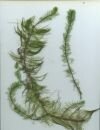Another Invasive Species Found in Lake Champlain

Variable-leaved watermilfoil –- the latest lake invader.
Aquatic biologists at Vermont’s Agency of Natural Resources (ANR) found a population of the invasive plant, variable-leaved watermilfoil, in the southern end of Missisquoi Bay. Similar to the native whorled watermilfoil, a rare plant species in the state, the variable-leaved watermilfoil was confirmed by genetic analysis this week from samples pulled during a routine water chestnut search last month in the bay.
Though variable-leaved milfoil is known in the Adirondacks, Lake Champlain is only the second confirmation of the species in Vermont. The first was found in Halls Lake in Newbury in 2008. The invasive plant has also been found in Massachusetts, New Hampshire and Quebec waters.
Based on the preliminary searching done in Missisquoi Bay last month, variable-leaved watermilfoil appears to be widespread in a large wetland complex of the southern portion of the bay and control options may be limited. ANR staff expect to conduct further surveys of the site in the next week or so.
Variable-leaved watermilfoil can be difficult to control once a population is established. Like Eurasian watermilfoil, which was confirmed in Vermont in 1962, the plant is able to grow in a wide variety of environmental conditions, is aggressive and grows rapidly. Dense growth of variable-leaved watermilfoil crowds out beneficial native aquatic plants and can impair recreational uses including boating, fishing and swimming.
Spread of this species occurs by stem pieces, roots and seeds. Plant parts can easily “hitchhike” on recreational equipment if not removed. Variable-leaved watermilfoil is also a popular aquarium trade species, which could be one of the ways it is spread.
Under Vermont’s Quarantine Rule, variable-leaved watermilfoil is a prohibited species. ANR staff, in cooperation with the Agency of Agriculture, Food and Markets, inspects Vermont aquarium retailers annually. In 2008, officials found two retailers in southern Vermont selling variable-leaved watermilfoil.
ANR recommends the following to help prevent the spread of this nuisance plant:
- Inspect boat, trailer, motor and other equipment for attached plant or animal material.
- Remove all plant and animal material.
- Discard removed material in a trash receptacle or on high, dry ground where there is no danger of them washing into any water body.
- Drain all water from boat, boat engine, and other equipment.
- Rinse all boat and trailer parts with tap water (preferably hot, high pressure).
- Dry boat, trailer and equipment out of water and in sun for at least five days.
- Become a VIP - Vermont Invasive Patroller - and monitor local waterbodies for new introductions of invasive species. Attend a training session and learn how to identify and search for invasive aquatic plant and animals as well as learning about native aquatic plants and animals and their habitats.
- Dispose of unwanted aquarium plants and animals in the trash. Don’t release any aquarium plants or animals into the wild.
